#British ceramist
Explore tagged Tumblr posts
Text
ˏˋ°•*⁀➷ poetry? no, pottery!



a lil’ love between you and little lando norris 💞 with a twist as you’re a ceramist/potterer!
content warning; none! just enjoy the fluffs! ah, there’s a bit of explicit language (i think?), but nothing drastic! enjoy 😽!
summary; childhood friends reconnect after years apart—he’s a formula 1 driver, and you’re a ceramist.
hey, lover! part two here!

Lando Norris was used to his friends teasing him. Whether it was his golfing misadventures, his love for Twitch streams, or his occasional emotional outbursts on team radio, there was always something to make him the subject of banter on and off the grid. But the one thing they had yet to figure out—something that he was genuinely proud of—was the pottery.
It started innocuously enough. A vase here, a decorative bowl there. The other drivers had assumed Lando had simply developed a newfound taste for ceramic art after moving to Monaco. Carlos had even joked once, “You’re just trying to look posh, mate.”
But no one had noticed the small etchings at the back of each piece: a simple ‘Lan’ with a heart. Subtle, personal, and not exactly the kind of thing you’d put on items for sale. That mystery had lingered until one fateful evening when everything unravelled in the most chaotic way imaginable.

It was post-race at Silverstone, and the whole grid had gathered for dinner at a private venue. Spirits were high after a spectacular British Grand Prix, with plenty of laughs and, naturally, plenty of friendly ribbing.
Lando sat beside Oscar, carefully monitoring his phone, knowing full well that at any moment you might call. You were in your apartment in Mexico, finalising details for an art exhibit while simultaneously working on personal pottery commissions. Lando adored how dedicated you were to your craft, even if it often left you so absorbed that you forgot things—like where you’d placed your keys, or, as he was about to find out, something a little more important.
Amid the loud chatter, Lando’s phone buzzed, and your name flashed on the screen. Without thinking, he swiped to answer. “Hey, love,” he greeted, but before he could say anything else, your panicked voice filled the room.
“Lan, I lost my ring! I don’t know where it is!”
Shoot, he forgot about the speaker.
The room fell eerily silent as the unmistakable sound of your frantic cries echoed from the speaker.
Lando froze. His brain short-circuited as he realised his phone was still on speaker. Every single driver at the table—except for Oscar, Alex, and George—was staring at him like he’d just confessed to murder.
“Oh, for fu—” Lando scrambled to turn off the speaker, but not before you continued, “Baby, I don’t know where it is! I can’t even—”
He interrupted, voice strained with embarrassment. “Have you checked the wet clays? That’s usually where you’d lose it.”
The line went quiet for a second as the realisation hit you. “Shit. I’ll go check. Thanks, love. Enjoy your dinner with the boys, bye!” You ended the call abruptly, leaving Lando to deal with the aftermath.
“What the hell was that?” Daniel was the first to break the silence, leaning forward with a grin that practically screamed mischief.
“No, who the fuck was that?” Max followed, his bluntness cutting through the rising chaos like a hot knife through butter.
The room erupted in questions. Pierre was halfway across the table, trying to pry answers from Lando, while Charles was practically yelling over everyone else. Meanwhile, Carlos gave Lando a pointed look. “Mate, don’t tell me you’ve got a secret girlfriend and you’ve been hiding it from me?”
Lando’s cheeks burned as he fumbled to explain. “Look, it’s not a big deal—”
“Not a big deal?!” Charles’ voice reached a pitch that only dogs could hear. “You’ve been holding out on us! Who is she?”
Amidst the chaos, Alex calmly took a sip of his drink and glanced at Charles. “You’ve met her before.”
“I have?” Charles frowned, genuinely confused.
George pulled out his phone, scrolled through his photos, and handed it over. “Here, this’ll jog your memory.”
The photo showed George, Alex, and you at a karting event years ago, laughing over slices of pizza. You were unmistakable, even with the short haircut and boyish charm you used to sport.
And the fact that you used to terrorise Charles on the grid.
Charles’ eyes widened. “You’re telling me that demon is Lando’s—”
“Fiancée,” Lando corrected with a smug grin, cutting him off. “She’s my fiancée.”
If the table had been chaotic before, it was nothing compared to the uproar that followed.
“Fiancée?!” Charles looked moments away from fainting. Pierre had to physically restrain him from climbing over the table.
Max, ever the straight shooter, raised a brow. “How long has this been going on?”
“Since October 2020,” Lando admitted, leaning back in his chair and crossing his arms defensively.
“You kept this a secret for three years?” Daniel looked simultaneously impressed and horrified. “And all we got were vases?”
“Wait,” Carlos interjected, pointing a finger at Lando. “The pottery—don’t tell me that’s her doing?”
Lando smirked, finally finding his footing in the conversation. “Actually, most of it’s hers. But I helped with a few pieces.”
“Explains the hearts,” Pierre muttered, earning a round of laughter.
Meanwhile, back in your studio, you’d found the missing engagement ring embedded in a chunk of wet clay. You snapped a quick photo of your clay-covered hands, the ring perched delicately on your finger, and sent it to Lando with the message: Found it. Your forgetfulness is rubbing off on me.
Lando responded with a selfie of his own, a defeated look on his face, and the message: The cat’s out of the bag.
You could only laugh, imagining the absolute carnage he was dealing with at dinner.

Now, the question is, how did you guys meet?
Well, let’s take a trip down memory lane, yes?
It started at a karting track in Guildford when they were both nine years old. Lando was already making waves on the circuit, a scrappy kid with untamed curls and an infectious grin. You, on the other hand, were a quiet but fiercely competitive racer, constantly being told you’d never make it because you were a girl.
That day, your paths crossed in the most cliché yet heartwarming way. You’d crashed during qualifying and sat on the sidelines, fuming as you inspected the damaged kart. Lando, fresh off his own session, wandered over with a bag of gummy bears and an awkward grin.
“Want one?” he asked, holding the bag out to you.
You glanced up, unimpressed. “Unless it fixes my kart, no thanks.”
“It doesn’t,” he admitted, plopping one into his mouth, “but they’re good for sulking.”
Reluctantly, you took one. That was all it took. From that day forward, you became friends—rivals on the track, co-conspirators off it. The karting world was small, and you often found yourselves travelling the same circuits, sharing snacks, and occasionally teaming up to prank the other kids.
But all good things come to an end, and for Lando, the end came when you abruptly quit karting at twelve. One day you were there, racing alongside him, and the next, you were gone. No explanations, no goodbyes—just a void where his fiercest rival and closest friend had been.
Years passed. Lando threw himself into racing, climbing the ranks to Formula 1, but he never stopped wondering what had happened to you. He’d hear whispers—something about pottery, about you exchanging one love for another—but nothing concrete.
Then, in 2020, he walked into a pop-up art gallery in London and froze. There, amidst a sea of ceramic sculptures, was a name he hadn’t seen in years: yours. And standing by a display of hand-thrown vases, chatting animatedly with a small group of people, was you.
Lando hesitated, heart pounding as he watched you laugh, looking so effortlessly radiant it hurt. He was a world-famous F1 driver now, but at that moment, he felt like the same awkward boy offering gummy bears to his angry rival.
Finally, he worked up the courage to approach you. “Hey,” he said, trying to sound casual. “Nice vases.”
You turned, your eyes widening in surprise. For a moment, neither of you spoke. Then, as if no time had passed at all, you grinned. “Nice curls.”
The conversation flowed as easily as it always had. Over coffee the next day, you explained why you’d quit karting. Your parents had pulled you out, worried about the pressure and the toxic environment you were facing as a girl in a male-dominated sport. You’d turned to pottery as an outlet and never looked back.
“I missed it, though,” you admitted, stirring your latte. “I missed racing. I missed… you.”
Lando’s heart clenched. “I missed you too.”
The transition from friendship to romance was seamless, almost inevitable. But given Lando’s high-profile career, you both agreed to keep the relationship private. It wasn’t easy. There were stolen weekends in Monaco, secret visits to your studio in between London and Mexico, and countless moments when you had to play it cool in public, even as your heart raced every time you saw him.
The secrecy was worth it, though. For three years, you built a world of your own, filled with laughter, late-night phone calls, and the kind of love that felt steady and enduring.
The proposal came during a quiet evening at your studio. You’d been working on a commission, hands covered in clay, when Lando appeared in the doorway, looking unusually nervous.
“What’s up?” you asked, wiping your hands on a rag.
He hesitated, then held out a small, unassuming box. “I, uh, thought we could make this official.”
You stared at him, heart pounding. “Lando Norris, are you asking me to marry you in the middle of my studio while I’m covered in clay?”
He grinned, the familiar boyish charm shining through. “Well, I figured it’s where you’re happiest.”
You couldn’t argue with that. Laughing, you took the box, opened it, and saw the ring—simple, elegant, and unmistakably you. Tears filled your eyes as you nodded. “Yes.”
For a while, life went on as usual. You returned to your pottery, Lando to his racing, and your engagement remained a secret known only to close family and a few trusted friends. But secrets have a way of slipping out, and yours did during that fateful post-Silverstone dinner.

By the time Lando returned home to Monaco, the internet was ablaze. He’d soft-launched your engagement on Instagram with a series of photos: your clay-covered hands holding the ring, more of you holding your ring in defeat after possibly losing it, and a final shot of the infamous ‘Lan ♥’ signature on one of your vases.
The caption read: ladies and gents, the chronicles of my fiancée losing her ring. she says that my forgetfulness is rubbing off on her apparently but she sadly chose to say yes to me 😌.
The response was overwhelming. Fans went wild over the reveal, speculating about your relationship timeline and falling in love with the wholesome chaos of it all.
Despite the initial embarrassment, Lando wouldn’t change a thing. Sure, Charles might never let him live it down, and Daniel would probably bring up the ‘wet clay incident’ at every opportunity, but none of it mattered.
As he watched you work on your latest piece, the soft hum of music filling the studio, he felt a sense of peace he rarely found anywhere else. You glanced over your shoulder, catching him staring, and flashed him a smile that made his heart skip a beat.
“Back to work, Mr. Norris,” you teased, pointing at the pottery wheel.
He grinned, sliding into the seat beside you. “Yes, ma’am.”
If this was what forever looked like, Lando was more than ready for it.
Because in the end, every gummy bear, every secret, and every chaotic dinner had been worth it.



i hope you guys liked it 🥹 tbh, this was originally a gift for my friend to motivate her but now she wants to actually marry him… i take no part in that declaration.
also, this y’all man 🤨☝🏻 damn, he’s okay, i guess.
i’m still very new here, so, there’s some things i absolutely know nothing about… BUT, i’ll get through it ٩(^ᗜ^ )و ´-!! i love y’all, strangers ‘round the internet 💌 MWAH!
#f1 x reader#lando norris x reader#pottery#ceramics#x reader#i don’t even know what i’m doing yall#send help#feeding your delusions with love and kindness#f1 fic#I DONT WHAT TO TAG 😭#fifty’s fics 🐇
523 notes
·
View notes
Text







Angela Mellor, British, from 1994 lives in Australia.
Bone China and Paperclay.
Angela tells her story: "My love of ceramics began whilst teaching in the 70s and I furthered my studies in 1984 at the University of East Anglia under the direction of Peter Lane, ceramist and author, who introduced me to porcelain. Later, in 1991, I studied bone china slipcasting with Sasha Wardell and fell in love with this seductive medium. In 1995 I went to live in Perth, Western Australia and travelled many times to Indonesia.
In 1997 I was kindly Invited to do research by Les Blakebrough in Tasmania, where I developed a bone china paperclay. By exploring its whiteness and translucency I was able to articulate my fascination with the distinctive qualities of light found there, being so close to the Antarctic. This was followed by a move to Melbourne where I completed a Graduate Scholarship for MA Research at Monash University. These opportunities afforded me the chance to develop my work in bone china and I pioneered the use of bone china paperclay, resulting in Honourable Mentions in International competitions in Japan and Korea.
The bright sunlight in Western Australia, and its effect upon the landscape, made a great impact on me and influenced the development of my work. On returning to Perth, I set up my own studio. An Australian Crafts Council Grant enabled me to collaborate with a lighting designer for a year so as to research the translucency of bone china, which has become the driving force in my work today."
26 notes
·
View notes
Text

..."frida ~ wallflower"..porcelain...vanessa hogge...kenyan born..british ceramist..sculptor..known for her decorative floral pieces made from black stoneware and porcelain....east london..england..uk...born 1963...
9 notes
·
View notes
Text
History
October 25, 1854 - During the Crimean War, the Charge of the Light Brigade occurred as Lord Cardigan led the British cavalry against the Russians at Balaclava. Of 673 British cavalrymen taking part in the charge, 272 were killed. The Charge was later immortalized in the poem by Alfred Lord Tennyson.
October 25, 1955 - Austria reassumed its sovereignty with the departure of the last Allied forces. The country had been occupied by the Nazis from 1938-45. After World War II, it was divided into four occupation zones by the U.S., Russia, Britain and France.
October 25-30, 1983 - The Caribbean island of Grenada was invaded by the U.S. to restore "order and democracy." Over 2,000 Marines and Army Rangers seized control after a political coup the previous week had made the island a "Soviet-Cuban colony," according to President Ronald Reagan.
Birthday - Artist Pablo Picasso (1881-1973) was born in Malaga, Spain. He was an experimental painter and also became a fine sculptor, engraver and ceramist.
0 notes
Photo




Hans Coper Angular Vessel
Impressed with the Artist's seal (on the underside). Stoneware with black burnish. Seight: 12cm.; 4¾in.; diameter: 10cm.; 4in. Executed circa early 1960s.
#Hans Coper Angular Vessel 1960s#stoneware#studio potter#british ceramist#art#artist#art work#art world#art news
12 notes
·
View notes
Photo

The Lorenzo Bandini Trophy (Italian: Trofeo Lorenzo Bandini) is an annual award honouring the achievements of an individual or team in Formula One motor racing.[3] The award was established by Francesco Asirelli and Tiziano Samorè of the Brisighella commune in 1992,[4] and is named after the Italian driver Lorenzo Bandini, who died three days after suffering severe burns in a major accident at the 1967 Monaco Grand Prix.[5] The accolade's trophy, a ceramic replica of Bandini's Ferrari 312/67 car adorned with the number 18 created by the ceramist Goffredo Gaeta,[6][7] is awarded for "a commendable performance in motorsport".[1] This is based on not the results attained but how the success was achieved,[8] and the recipient's character and approach to racing.[9] Each recipient is honoured for their achievements over the course of the previous year.[4] A panel of 12 judges, composed of motor racing journalists and former Formula One team members, determines the recipient of the award.[10] Previously, the winner was decided by a vote from the residents of Brisighella.[5] The winner is honoured at a ceremony in Bandini's home town of Brisighella in Emilia-Romagna,[a] and the trophy is presented by the Associazione Trofeo Lorenzo Bandini.[10]
The accolade is considered highly prestigious in the world of motor racing.[3][11] The inaugural winner was the Italian driver Ivan Capelli in 1992.[12] No award was given in each of 1993 and 1994 and no-one has won more than once since drivers are only allowed to be a named a recipient just once to give other racers the opportunity to win it.[4][12] Although the award has usually been given to racing drivers for their achievements from the previous season, it has been awarded to two racing team members: the Ferrari president Luca Cordero di Montezemolo (1997),[12] and the marque's vice-chairman Piero Ferrari (2013).[13] The accolade has been won by racing teams on two occasions:[1][7] the Mercedes AMG Petronas F1 Team for winning the World Constructors' Championship with a V6 engine coupled with hybrid technology (2015),[1] and Scuderia Ferrari to commemorate the 70th anniversary of its establishment (2017).[7] It has been presented to Italian drivers and teams on eight occasions, followed by German competitors and constructors with four wins and three for British racers. The 2021 winner was the Ferrari driver Charles Leclerc.[2]
#kevin magnussen#WAKE UP BITCHES KEVIN JUST WON AN AWARD!#a highly prestigious one too#i'm so happy for kev 😭#he deserves some recognition for his time in f1
35 notes
·
View notes
Photo

Plaque, John Bennett, 1879, Art Institute of Chicago: American Art
Working at the London firm Doulton and Company, English ceramist John Bennett evolved a new method in which he painted his designs in slip, or liquid clay, and covered them with clear glaze. In 1876 “Bennett ware” was exhibited to great acclaim at the Philadelphia Centennial Exhibition, prompting Bennett to relocate to New York. Although his early pottery demonstrates Islamic influences, this plaque is more indebted to contemporary British Aesthetic movement design. Flowers in muted colors extend into the composition from beyond the pictorial space, yielding a design that resembles the intricate textiles of English artist William Morris. Through prior acquisitions of the George F. Harding Collection, an anonymous donor, Bessie Bennett, Mrs. William Blood, Emily Crane Chadbourne, Milton Straus, Elizabeth R. Vaughan, Behrend/Sanford Auction and Thorne Rooms Exhibition funds Size: 46.7 cm (18 3/8 in.) Medium: Earthenware
https://www.artic.edu/artworks/150063/
2 notes
·
View notes
Photo







Kazunori Hamana
Japanese, born in 1969 Lives and works in Chiba, Japan
‘The artworks of Kazunori Hamana have the once-inhabited presence of shells from which all things organic have been scraped out, or of objects whose surfaces have been washed smooth by the sea. Sometimes bearing engravings and scratches, the works echo the sea environment from which the artist draws his inspiration. A self-taught ceramicist, Hamana settled in Isumi, Chiba prefecture where he shares his time between working as a fisherman and a craftsperson. Over a time consuming process, Hamana's irregular pots are built from coils and get their unique skin from scratches and scored glazes. Hamana's works reconnect with the simplicity and humbleness of a vernacular tradition of ceramic.’
Hamana will always have a place in my small handful of beloved ceramists. My adoration of his work is simply overwhelming, and I’m in awe of the immense presence these vessels hold within a room. I always think back to the tremendous presence held by Oh Hyang-jong’s Onggi pots, which occupied the Spode China Works in 2017 (https://londonkoreanlinks.net/2017/12/04/a-visit-to-the-british-ceramics-biennial/). Another artist that has this wonderful ability to balance between the materiality of the object and its surroundings, creating and then navigating their existence is Nancy Fuller:


These pots were so incredible to view in person when I went to see her show in Hauser & Wirth a few weeks ago. What amazes me, is that although Oh Hyang-jong utilises the sheer size of the pots to create presence, Fuller and Hamana’s vessels aren’t actually that large in size and are able to achieve the exact same, if not more striking, feeling of occupation and existence within a space. I think, as someone who is trying to build a bridge between intangible thought matter and physical object, I perceive the space held by such vessels similar to the thought space held within my awareness. These physical objects seem to capture something which I haven’t fully figured out yet- but, the feeling is there and its a really strong one.
(Hamana image source: http://www.pierremariegiraud.com/en/artistes/cv/3966/kazunori-hamana)
(nov ‘20)
2 notes
·
View notes
Text
Referencing
Apartment Therapy (2020) "Interior Doors Like Nothing You've Seen Before"
Available at: https://www.apartmenttherapy.com/interior-doors-like-nothing-youve-seen-before-230320?utm_source=pinterest&utm_medium=tracking&utm_campaign=inline-img-share&epik=dj0yJnU9Slg3N25KeWhZY0V5eFIzVWlocXRvNllhXzNJWUVFel8mcD0wJm49d3l2V1M5dzFCMlJ0NzExZlpIS0JSUSZ0PUFBQUFBR09fczBv
(accessed 03/01/2023)
-
Homenish (2021) "14 Hardwood Floor and Wall Colour Combinations for a Cohesive Design"
Available at: https://www.homenish.com/hardwood-floor-and-wall-color-combinations/
(accessed 03/01/2023)
-
Italian Bark (2019) "HOME TOUR"
Available at: https://www.italianbark.com/interior-design-pantone2019-livingcoral/
(accessed 30/11/2022)
-
MEDIUM (2020) "100 years of Cooper Black"
Available at: https://medium.com/swlh/fat-face-100-years-of-cooper-black-cf7735f68699
(accessed 15/12/2022)
-
PSU Vanguard (2019) "Sustainable Isn't Accessible"
Available at: https://psuvanguard.com/sustainable-isnt-accessible/
(accessed 28/11/2022)
-
Simon Kämpfer (2020) "Plain English & British Standard"
Available at: https://www.simonkaempfer.com/plain-english-british-standard
(accessed 29/11/2022)
-
WGSN (2021) "The Rise of Personal Expression"
Available at: https://www.wgsn.com/interiors/p/article/90750?lang=en&_fsi=HlqIpCTh
(accessed 10/12/2022)
-
WGSN (2022) "What is Circular Design?"
Available at: https://www.wgsn.com/en/blogs/wgsn-sustainability-glossary-what-circular-design-0
(accessed 13/12/2022)
-
Yanko Design (2022) "Elisa Uberti's ceramic handcrafted lamps are beautiful pieces of art"
Available at: https://www.yankodesign.com/2022/05/20/elisa-ubertis-ceramic-handcrafted-lamps-are-beautiful-pieces-of-art/
(accessed 02/01/2023)
-
1BHK Interiors (2021) "Seven Reasons to Choose Custom Furniture"
Available at: https://www.1bhkinteriors.com/blogs/news/customised-furniture
(accessed 04/12/2022)
0 notes
Text
INSPIRATION
CERAMICS
Gareth Mason b.1965, Wales

Glen Adamson was right when he said that a single one of Gareth Mason's pots "may contain as many ideas as a whole archaeological pit"— each work by Gareth Mason is a ceramic microcosm.
Intensely expressive and energetic in character, his sculptural vessels reflect an eagerness to capture the dynamics and the mysteries of creation. Immersed in the transformative power of fire, Mason’s spirit is freed through earth – his artistic medium – and thus his ceramics develop vibrant personalities of their own. It is metamorphic process which occasionally takes years: from wheel-throwing and through to all of the subsequent manipulations, firing and glazing, as well as composing of varied materials.
The result in each case is an astounding richness in texture, form, and visual density— work which rewards sustained sttention. Unconventional in his approach, Gareth Mason is one of Britain’s most original ceramists. He has extensive experience as a teacher and has been featured in a number of exhibitions and publications on contemporary art pottery, including "Things of Beauty Growing": British Studio Pottery at the Yale Center for British Art in New Haven, Connecticut (2017). His most recent solo exhibition, Carnul Flux (2020), took place at the Everson Museum of Art, to great acclaim.
Mason is a Fellow of the Craft Potters Association and Brother of the Art Workers Guild, London. A short film about his practice entitled "White" won the Grand Prix at the 2002 Projections d’Argile festival in Montpellier. In 2009, he exhibited at the World Ceramic Biennale in Yeoju, Korea. Mason held his first solo exhibition, Other Forces, at Jason Jacques Gallery in 2011.




What I connect with…
The interrupted forms. I need to interrupt my forms more, and follow the creative process by looking at what is working for me, letting that guide me, instead of shoe horning concepts into my material research.
I also connect with the exploration of colours and multitude of surface textures within each work. Microcosm is definitely a good description.
0 notes
Photo

"A Ceramist Inspired by Folklore and the British Countryside" by BY ALICE NEWELL-HANSON AND SIAN DAVEY via NYT T Magazine https://ift.tt/2YasPSo
0 notes
Text
History
October 25, 1854 - During the Crimean War, the Charge of the Light Brigade occurred as Lord Cardigan led the British cavalry against the Russians at Balaclava. Of 673 British cavalrymen taking part in the charge, 272 were killed. The Charge was later immortalized in the poem by Alfred Lord Tennyson.
October 25, 1955 - Austria reassumed its sovereignty with the departure of the last Allied forces. The country had been occupied by the Nazis from 1938-45. After World War II, it was divided into four occupation zones by the U.S., Russia, Britain and France.
October 25-30, 1983 - The Caribbean island of Grenada was invaded by the U.S. to restore "order and democracy." Over 2,000 Marines and Army Rangers seized control after a political coup the previous week had made the island a "Soviet-Cuban colony," according to President Ronald Reagan.
Birthday - Artist Pablo Picasso (1881-1973) was born in Malaga, Spain. He was an experimental painter and also became a fine sculptor, engraver and ceramist.
0 notes
Link
Matter and spirit: Shazia Zuberi’s new series of ceramic sculptures is on display at Art Chowk Gallery, Karachi | Art & Culture | thenews.com.pk Have you ever gone for a walk in the upper zones of Hunza and Nagar? One may take the chance to explore them and immerse in their ancient feel, allowing their serenity to descend upon one and find new inspiration in their endless wealth of natural forms. On these walkabouts, one may invariably stumble upon remnants of white settlements from gold-digging days. Old chimneys and ruined brick walls, ceramic shards and rusty, half disintegrated tins never fail to conjure their ghostly dwellers to one’s imagination. Their presence is almost tangible, yet time always keeps them well out of reach. One may get overcome by a similar feeling upon seeing Shazia Zuberi’s new series of ceramic sculptures titled: ‘Markhor’ (the mountain ibex) Art Chowk Gallery, Karachi. The lack of a prescribed background of formal education in the visual arts makes the rapidity of Zuberi’s emergence as an acclaimed ceramist all the more remarkable. She has achieved a level of technical expertise and sophistication to accompany her natural flair for creating distinctive and imaginative ceramics. Both cerebral and intuitive in their making, her glazed and slip-covered pieces exhibit qualities derived from the landscape. Surfaces encrusted with organic cavities and curves of varying sizes allude to appearances and textures found in the natural environment. These intrepid exteriors created by the glaze are complemented by a wealth of striking colours, combining to conceal the underlying fragility of the forms. Zuberi’s work seems representational in its portrayal of the recognisable characteristics of the landscape. As a painter applies paint to canvas in order to capture the essence of a place, so Zuberi introduces glaze to clay. The subsequent kiln-firing, facilitating a synthetic and accelerated re-enactment of environmental effects upon the earth’s surface, transforms the glaze into a bas-relief of limestone cliffs and mineral deposits. Remnants of ruined architectural forms can also be suspected lurking in the detail of numerous pieces. Dry stone walls, castle fortifications and various other fragments of man-made structures seem to be revealed and belie a landscape that is pure and untainted. Instead, Zuberi addresses a landscape that is contemporary, scarred and littered with the evidence of human existence; a landscape that is reclaiming its territory by consuming all that is external to it. The ibex as a leitmotif has been central to Zuberi’s practice in the new body of work, likened to the situation the entire mankind is caught in due to the Corona pandemic. Like markhor, the shy, reticent, recoiled goat species that lives hidden away from the human eye in isolation, the pandemic subjected the humankind to isolation. In some pieces, she has attempted to retain the fundamental properties of archetypal vessel forms; the shallow bowl and the plate. Inherited from post-modernism, this loyalty to traditional vessel forms seems to distinguish pottery from sculpture. Although based in function and made of clay, the forms she has chosen to concentrate on – the plate, the bowl – allow her to explore and expand pure object/space relationship. A horizontal plane, parallel to the table surface – the plate, a place to rest food. The transitional plane, diagonal to the table surface – the bowl, a form to hold a liquid. While each form stands on its own with strength, consistent with the tradition of function, each also benefits and grows from interaction with the end user. These are not just some generic decorative forms but can be considered objects of use. A group of heads, all Untitled, much similar in colour, form, size and expression, have a dry and earthy quality to them. In this case, an off-white is thinly and unevenly brushed on over underlying layers of rusty brown and even a pastel like green. These underlying colours are only visible here and there, appearing in small patches through the transparent white or in uncovered spots. The depth thus created in the surface lends the pieces a sense of history. Their volume and interior space speak of a living content. They strongly convey the feeling that these forms are living beings from a distant past, possibly merged with natural but lifeless rock forms. The free-flowing ibex drawings on the surface are like rock paintings or engravings, cultural symbols, abstract remnants of a ritual activity. On a formal level, multiplied shapes are visually pleasing, and provide the comfort of the expected. About a generation after William Morris and John Ruskin, British mathematician and philosopher Alfred North Whitehead stated: “Art is the imposing of pattern on experience, and our aesthetic enjoyment is recognition of that pattern”. Process philosophy, on the one hand, identifies the ‘real’ with change and dynamism. Zuberi takes a cue from that line of thought because she creates definitive and discrete objects that have an enduring quality, and then combines them, which indicates the potential for transformation. The individual pieces are moveable, like checkers on a board. If the elements are chips on a game board and the game that Zuberi intends to convey is the complexity and interdependence of nature, the chips take on an anthropomorphic quality with humans as participants in, and subject to, something larger than themselves. Zuberi makes forms that provoke contrasting reactions, they embody a range of sentiments and they merit quiet contemplation. A love for her material and craft has enabled her to produce an extensive body of work over the years. The past few years have resulted in the form becoming more sensual and sophisticated, the scale gradually increasing and the method of structure dynamic. There is finesse in both making and in finish. The glazes have become richer, achieving a range of colour through soft iridescent golds, browns to black. As with her mentors, Zuberi finds no disadvantage in the preferred use of the electric kiln over gas. Of course, she is concerned with touch too; the way the pot, made by the hand for the hand, sits in one’s grasp is an important feature. Viewers are encouraged to touch as well as look, the balance of form and glaze offering a satisfying tactile experience as well as a visual one. Surfaces that are seemingly coarse to the eye are in fact smooth to the touch. Unfortunately, invitations to touch do not occur within the gallery environment, galleries are, of course, reluctant to jeopardise artwork or claim against their considerable insurance premiums. It is the artist’s prerogative to allow chance and opportunity play a role in the work that she produces. Like the human DNA, where variety grows from the combination of similar original elements, the original DNA of these objects has set up a vast resource for Zuberi. The choice to work within the confines of an established set of rules, together with the potential variations, sets the stage for an amazing variety. The writer is an art critic based in Islamabad https://timespakistan.com/matter-and-spirit-shazia-zuberis-new-series-of-ceramic-sculptures-is-on-display-at-art-chowk-gallery-karachi-art-culture-thenews-com-pk/7345/
0 notes
Text
Британский керамист Tamsin van Essen представила серию работ под именем "Erosion"
http://zpdlo.com
Британский керамист Tamsin van Essen представила серию работ под именем “Erosion”. Тамсин живет и функционирует в Лондоне. Важной чертой её творчества является постоянное экспериментирование, например, исследование свойств и особенностей керамических покрытий, как в данной серии.
0 notes
Text
Walter Hoyle
Walter Hoyle is in danger of being one of the forgotten Great Bardfield artists due to the lack of information on him.
Hoyle was born in Rishton, Lancashire in July 1922. Hoyle's artistic education started at the Beckenham School of Art in 1938,
I persuaded my local art school to accept me, and presented as evidence of my serious intent, a series of drawings much influenced by Walt Disney. †
From Beckenham, Hoyle gained a place at as a student at the Royal College of Art from 1940-42 and again from 1947-48 after serving in the Second World War. During Hoyle’s time at the RCA one of his tutors was Edward Bawden, who encouraged him to develop watercolours and printmaking.
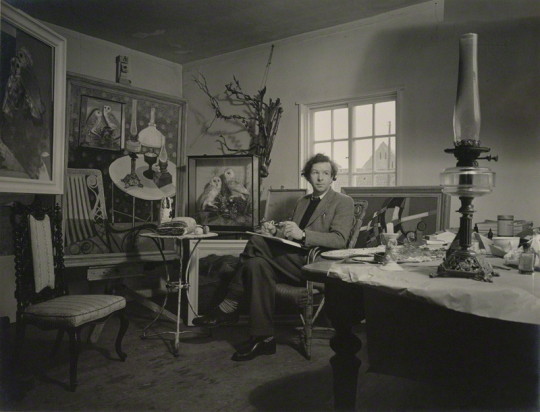
Walter Hoyle at home in Great Bardfield, NPG, taken by Geoffrey Ireland.
It was 1940, the phoney war was to about to end and the college was evacuated from London to Ambleside in the Lake District, famous for poets rather than artists. It was here that I was first introduced to printmaking – lithography – by a friend called Thistlethwaite, a fellow student from Oswaldtwistle (although these names are true, I mention them only because I like the sound they make). He prepared a litho stone for me with a beautiful finely ground surface and instructed me how to draw in line and wash. †
In 1948, During the RCA Diploma show, a visitor was so impressed by Hoyle's work that he was offered seven months' work in the Byzantine Institute in Istanbul, Hoyle accepted, the work he saw there made a strong impression. Italian art and architecture also influenced him at that time.
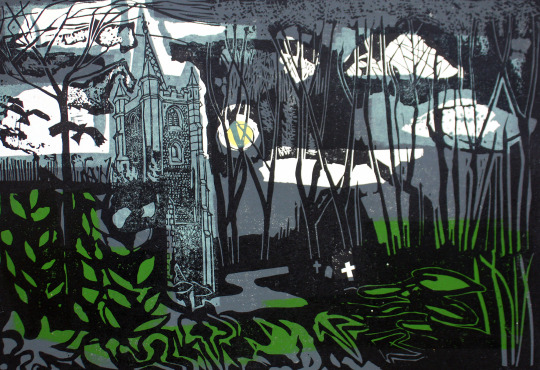
Walter Hoyle - Church Moon, Little Samford (In My Collection) ,1957.
Early in 1951 when Bawden was commissioned by the Festival of Britain to produce a mural for the Lion and Unicorn Pavilion on the South Bank, it was Hoyle that he chose to assist him on account of his great talent. During that summer Bawden invited Hoyle on a holiday to Sicily.
Edward asked to see my watercolours. He looked very carefully and quizzed me about them, and in general was complimentary and encouraging. I felt I had passed some kind of 'examination. ♠
It was this holiday together that Hoyle would scribe into a limited edition booklet of 10 in 1990 and into a book in 1998 - “To Sicily with Edward Bawden” a limited edition of 350 copies with a forward by Olive Cook.
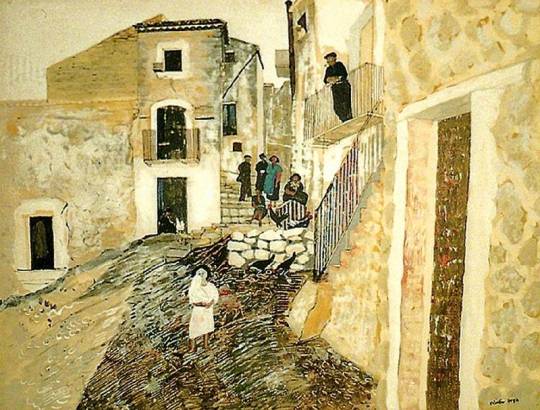
Walter Hoyle - Hill town in Sicily, ex Cambridge City Council, 1951.
In 1952 Hoyle took over the painting of another mural, the dome of St Mary Abchurch, London. The church had been blitzed in September 1940, and the original mural was being restored by E. W. Tristan, but when Tristan died, Hoyle completed the work. ‡
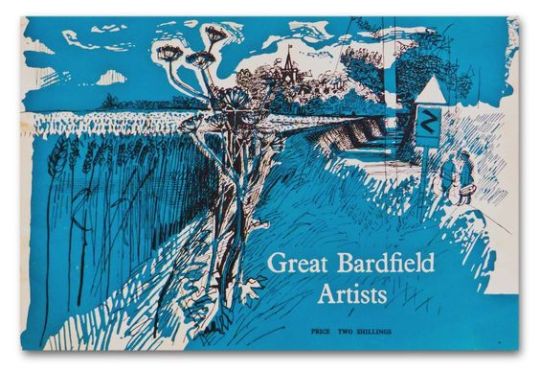
Walter Hoyle - The cover for the Great Bardfield Exhibition booklet.
The move to Great Bardfield: Hoyle moved first to Great Bardfield in 1952, living for a time in a farm cottage on the outskirts of Bardfield near Great Lodge Farm. He lived and worked in the Great Bardfield area for twenty-two years and exhibited with the Bardfield artists in 1954, 1955 and 1956 when they would open their houses to the public for one weekend a year, rather than relying on London galleries. Hoyle met his wife, the ceramists and poster designer Denise Hoyle at at one of the Great Bardfield “open house” exhibitions in 1956, when his work was on show at George Chapman’s house.
It may have been Edward Bawden's painting classes and lectures at Brick House, or being in the hilly Essex countryside but it around this time that Hoyle became interested in English romantic painting: the work of Turner, Blake and Palmer and also in French art. Like other members of Great Bardfield, Hoyle designed for interiors with wallpapers and fabrics for Coles, Sandersons and the Wallpaper Manufacturers Limited.
One of Hoyle’s most popular works for book illustration came with a commission for the Folio Society in 1968 with Shirley by Charlotte Bronte.

Walter Hoyle Design for Sandersons
Teaching: Walter Hoyle has taught at various art schools: St. Martin’s, London, 1951-60; the Central School of Art, London, 1960-64; and the Cambridge School of Art, 1964-85.
Walter Hoyle left Great Bardfield and moved to Bottisham, Cambridgeshire, to teach at the Cambridge School of Art in their printmaking department. While at Cambridge, he launched the Cambridge Print Editions, publishers of the magazine of the Cambridge School of Art, “Private View” co-edited by Warwick Hutton, which he started and which included interesting extracts from the work of famous artists and writers such as Patrick Heron and Edward Ardizzone, as well as articles by students and graduates of the school.
Hoyle took over the collection of ‘Original Works for Children in Cambridgeshire’, an art project for City of Cambridge Committee for Education. Hoyle donated a picture and convinced other artists to give works to the project too. He retired from teaching in 1985 to move to Hastings and Dieppe. Hoyle died in 2000.
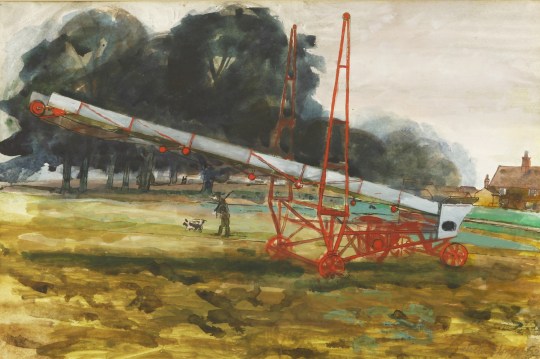
Walter Hoyle - Great Lodge Farm, 1952 (In My Collection)
Exhibitions and Collections: Hoyle exhibited internationally working outside of the Bardfield set. Exhibitions were not only at the Byzantine Institute Gallery in Paris in 1950, but in 1952 he showed at the Leicester Galleries, London. He was featured in many mixed exhibitions in London and the provinces, including the Royal Academy summer exhibitions and Kettles Yard, Cambridge (1972). Walter Hoyle is represented in many public and private collections, among them the Bibliothéque Nationale, Paris, the Victoria and Albert and the British Museums, the Tate Gallery, the Walker Art Gallery, the Whitworth Art Gallery, the Fitzwilliam Museum, the Sheffield Art Gallery, the Manchester City Art Gallery, Editions Alecto Gallery, London, and the Palace of Westminster and the Fry Art Gallery in Saffron Walden.
He painted murals for the Natural History Museum, for the Jamestown Festival, USA, and for the Sealink ship “St. David”.
Editions of his prints have been commissioned by Editions Alecto, Christie’s Contemporary Art, Neve International, the British Oxygen Company, the Folio Society and St. Catharine’s College, Cambridge.
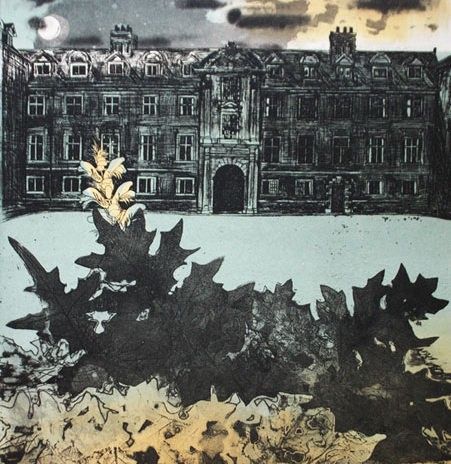
Walter Hoyle - St Catherine’s with Acanthus, (In My Collection), 1966
† Printmaking Today, Volume 7, 1998. page 9-10. ‡ https://en.wikipedia.org/wiki/St_Mary_Abchurch ♠ To Sicily with Edward Bawden, Previous Parrot Press, 1998. The Great Bardfield Exhibition by Gerald Marks, Realism, August — September 1955 ♣ http://www.fryartgallery.org/the-collection/search-viewer/691/artist/15/Walter-Hoyle--/22
5 notes
·
View notes
Text
Ask Me Anything....!
During the mid-term break, I was thinking about the topic for my project 3 which is ‘Ask me Anything…’ I need to come up with 5 subject topic, it can be a historical artist/ designer, art movement, object, architecture, and typeface. I found it hard to come up with several topics as I don’t what topic should I choose, so I did some research and I got some topic that I interested in which are Picasso, Times New Roman, Baskerville, and Memphis art movement.
1. Picasso
Pablo Picasso is a Spanish painter, sculptor, printmaker, ceramists and theatre designer. Every a short period of time, he changed his artworks style as he experiment with different theories, techniques, and ideas. I’m interested in one of his period which is Blue Period (1901-1904). It is a term when he was painting his artwork by using a monochromatic colours of blue and blue-green, and sometimes use a little warm colours. Picasso used these colours as he sank into a severe depression and blue tones began to dominate his paintings. I really like his works as he has own characteristic for his artworks and how he creates kind of abstract portrait.
2. Memphis art movement
Memphis group was an Italian design and architecture group, it actives between 1980-1987. This era of design was influenced by Pop Art and Art Deco with a twist of kitsch. The group created lighting, furniture and textiles designs that were bright, colourful, geometric and bold. I’m very interest on the characteristic of the designs which creates a fun atmosphere.
3. Times New Roman
It is a serif typeface and it was commissioned by the British newspaper, The Times. As it was used in a daily newspaper, the font became one of the most popular typefaces among printers of the day and its available for each devices. This typeface is simple and easy to read, a a result many people like to use for writing an article. I want to explore this typeface as i’m curious why this font is being very popular.
4. Baskerville
It is a serif typeface which designed by John Baskerville. It is classified as a transitional typeface which means it sits between classic, mathematical, and modern typeface which feature high contrast between stroke weights. This typeface is new for me as I never used it but I get attract by the characteristic of the font and it historical background.
Among these topic, I might choose the typeface topic as I’m interested in typography and i want to explore further about it but I’m confuse which one should I pick as my topic, so I will discuss it on next class with Ben. I hope I can decide after I get feedback from him.
0 notes